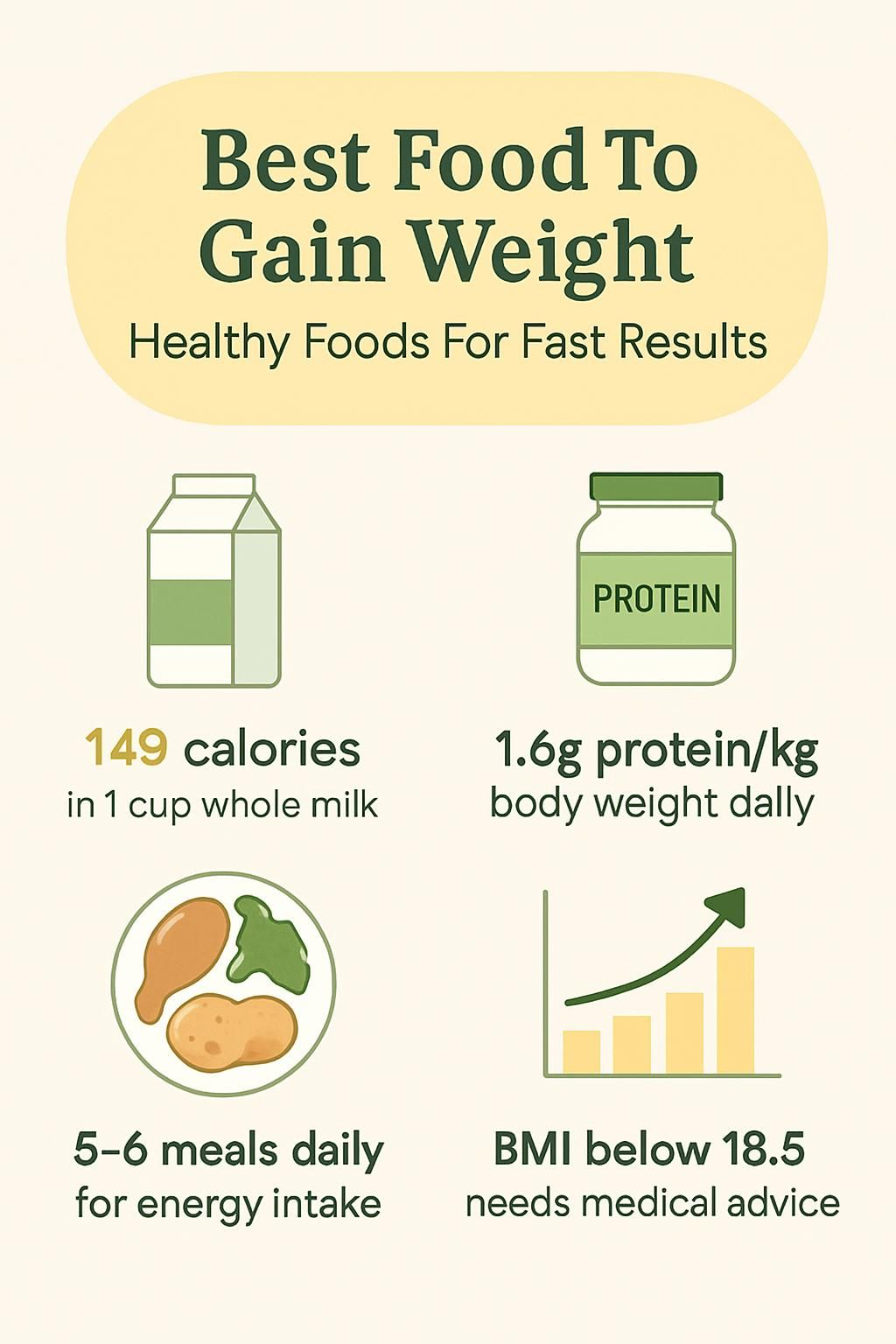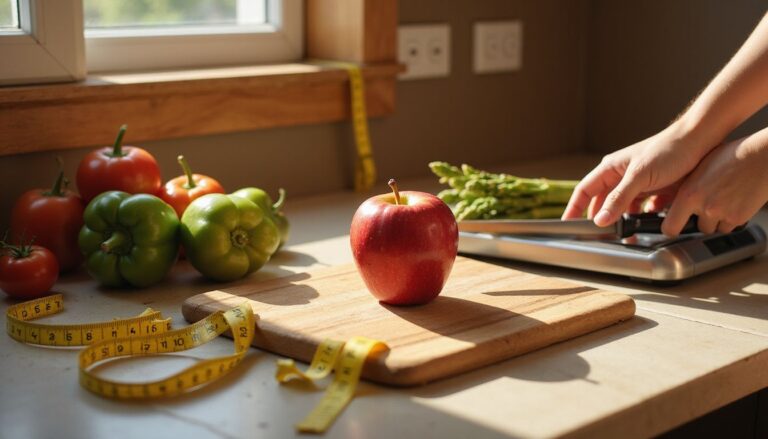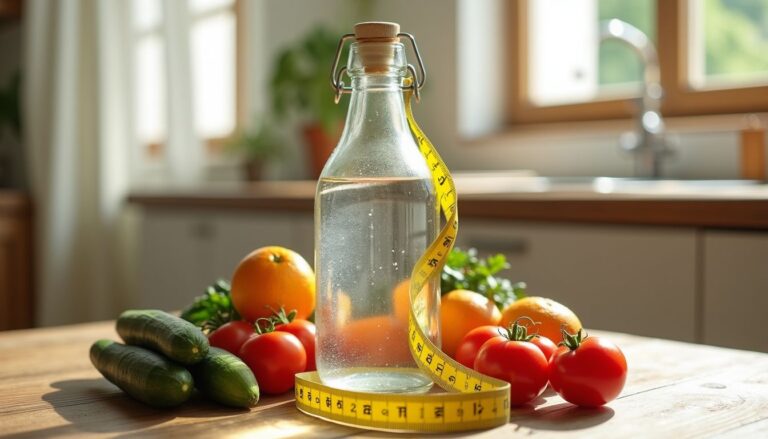Best Food To Gain Weight: Healthy Foods For Fast Results
Our Nutrition Assistant AI Suite will transform your body. You will lose fat, get toned, and build muscle. Gain confidence and optimal health.
If you need to gain weight but struggle to see progress, you are not alone. Healthy weight gain is possible with the right plan, even if appetite is low. The key is choosing high-calorie foods that also deliver important nutrients.
Best Food To Gain Weight centers on options like nuts, nut butter, rice, whole milk, red meat, and protein-packed smoothies. These choices help you gain weight fast while supporting your health. They add extra calories without relying on junk food.
In this guide, you will learn simple meals and snacks that can add hundreds of calories each day. You will also see how strength training helps you build muscle, not just body fat. Use these steps to make steady progress in a safe, healthy way.
Key Takeaways
- Choose calorie-dense foods that also offer nutrients, for example whole milk at 149 calories per cup, red meat at about 228 calories per 3 ounces, and nuts at roughly 170 calories per quarter cup of almonds.
- Combine strength training with adequate protein. A 2022 review of 74 studies suggests at least 1.6 grams of protein per kilogram of body weight each day supports muscle gain.
- Eat frequently, aim for 5 to 6 meals or snacks daily. Use larger portions and calorie-dense toppings like cheese, nut butter, and oils to raise daily energy intake.
- If you have a BMI under 18.5 or unexplained weight loss, see a healthcare professional. Conditions like malabsorption can make weight gain difficult.
- Balanced plans that include smoothies, dried fruits, granola, avocados, and dairy help you add weight steadily while protecting health and muscle.

What Are the Main Challenges When Trying to Gain Weight?

Gaining weight can feel hard for many reasons. Low appetite, a fast metabolism, high activity, medical issues, and poor nutrient absorption all play roles. A Body Mass Index, or BMI, under 18.5 means you are underweight for your height.
Three large meals can feel tough if your appetite is low. Digestive problems like malabsorption and chronic illness can reduce how many calories and vitamins your body can absorb. If you lose weight without trying, talk with a doctor or a registered dietitian.
Research also shows that some children older than two may struggle with weight even in food-secure homes. Recovery after illness and aging can lower appetite and reduce muscle protein synthesis, which is the process your body uses to build new muscle.
You need more than extra calories. Focus on nutrient-rich foods and a steady plan. This approach supports your health while you add weight over time.
Key Principles for Healthy Weight Gain
Healthy weight gain starts with calorie-dense foods and consistent habits. Build meals that deliver protein, carbs, and fats in every plate or bowl. Add small boosts across your day to keep the total rising.
Which Calorie-Dense, Nutrient-Rich Foods Should I Eat?
Choose high-calorie foods that also supply protein, healthy fats, vitamins, and minerals. Full-fat dairy like whole milk and Greek yogurt adds calories and protein fast. One cup of cooked white rice provides about 204 calories, making it an easy base.
Good protein sources include beef, eggs with the yolk, salmon or tuna, chicken thighs, beans and lentils, and tofu. Nuts and nut butter give healthy fats plus plant protein. One tablespoon of peanut butter has about 90 to 100 calories. Avocado is rich in heart-healthy fats and vitamins E and C.
Easy snack ideas:
- Trail mix with dried fruit, nuts, and seeds.
- Crackers topped with hummus or cheese.
- Sliced avocado on sandwiches and wraps.
- Whey mixed into smoothies or oatmeal.
Tip: Increase portion sizes slowly. Doubling fruit and vegetable servings at meals helps you eat more without feeling stuffed.
How Do I Balance Proteins, Carbs, and Fats for Weight Gain?
Balance your plate. Aim for at least 1.6 grams of protein per kilogram of body weight each day. This target supports muscle protein synthesis, the process that builds new muscle, especially with strength training.
Pair carbs like rice, quinoa, potatoes, oats, or beans with protein from eggs, whey, red meat, poultry, or strained yogurt. Add healthy fats with olive oil, avocado, nuts, or seeds. One tablespoon of oil adds about 120 calories.
Whole eggs give quality protein and fats in one food. Combine these macronutrients at each meal to raise calorie intake and support recovery.
“Combining proteins with complex carbs and healthy fats increases meal quality and supports healthy weight gain.”
Why Is Strength Training Important for Muscle Growth?
Food fuels growth, but you need a signal for muscle to grow. Strength training supplies that signal. It helps your body direct extra calories into lean mass instead of fat stores.
Red meat contains dietary creatine, which supports muscle hypertrophy, meaning muscle size increases, when paired with lifting. A 2022 review found that adding red meat to a training plan can increase lean mass and reduce age-related muscle loss.
Lifting often raises appetite too, which makes eating enough easier. Many people find a simple routine, like three to four sessions per week, drives faster progress than diet alone.
Best Foods to Help You Gain Weight Quickly
Fast progress comes from calorie-dense staples you can eat often. Build a short list you enjoy, then repeat it through the week.
How Can I Make Protein-Packed Smoothies at Home?
Protein smoothies are quick, portable, and easy to customize. They pack calories without a large meal.
- Use a base of whole milk or Greek yogurt. One cup of whole milk adds about 150 calories.
- Add a scoop of protein powder, for example whey, plant, or casein. One scoop often provides around 120 calories and all essential amino acids.
- Blend in fruit like banana, berries, or pineapple. One banana adds roughly 105 calories.
- Add one tablespoon of nut butter for healthy fats and extra calories.
- Leafy greens, avocado, or cocoa powder can boost nutrients without overpowering flavor.
- Mix in oats, cooked white rice, or chia for extra carbs and fiber.
- Example: Blend 1 banana, 1 scoop chocolate whey, 1 tablespoon peanut butter, and whole milk for a 350 to 400 calorie shake.
- Use frozen fruit for thickness, or ice for a lighter texture.
- Limit added sugar. Rely on the natural sweetness of fruit.
- Adjust ingredients for allergies. For example, swap nut butter for sunflower seed butter.
What Are the Benefits of Whole Milk and Dairy for Weight Gain?
Whole milk is calorie-dense and nutrient-rich. One cup has about 149 calories and 8 grams of protein. You also get calcium and vitamins that support bone and muscle health.
Greek yogurt made from whole milk delivers about 165 calories and around 15 grams of protein in half a cup. Cheese adds quick calories, for example one ounce of cheddar has about 110 calories and 7 grams of protein. Stir dairy or soy milk into oatmeal to raise breakfast calories with little effort.
Comfort dishes like mac and cheese deliver even more energy. Pair dairy with rice or grains to lift total calories in a balanced way.
Which Rice and Grains Are Best for Adding Calories?
Rice and grains are easy to eat even when appetite is low. One cup of cooked white rice provides about 204 calories and 44 grams of carbs. It is affordable and quick to cook.
High-calorie grain picks include oats, quinoa, granola, buckwheat, and wild rice.
- Half a cup of granola often has 200 to 300 calories.
- A bowl of quinoa with roasted sweet potatoes can reach about 336 calories.
- Wild rice paired with chicken and greens can hit around 400 calories per meal.
Thicker breads, like seeded or sourdough, add extra energy at breakfast. Stir granola into Greek yogurt to add hundreds of calories in a simple snack.
Why Choose Nuts and Nut Butters for Weight Gain?
Nuts and nut butter are small in volume and big in calories. A quarter cup of almonds has about 170 calories, 6 grams of protein, and 15 grams of fat.
Two handfuls of mixed nuts can add several hundred calories without making you feel stuffed. Nut butter on toast, in oatmeal, or stuffed in dates turns a quick snack into a muscle-supporting mini meal. If you have allergies, use seed butters and pick options labeled 100 percent nut or seed.
Which Red Meats and Lean Proteins Support Healthy Weight Gain?
Red meat gives protein, iron, zinc, and leucine, an amino acid that triggers muscle building. A 3 ounce steak provides about 228 calories and 24 grams of protein. It also supplies creatine that supports performance in the gym.
Choose fattier cuts like ribeye or brisket if you need more calories. Research in 2022 suggests that moderate red meat intake alongside lifting can increase lean mass and reduce muscle loss with age. Limit red meat to about 50 grams per day on average to lower long-term colorectal cancer risk.
Round out your plan with chicken, turkey, tuna, or eggs. These lean proteins fit well in casseroles, sandwiches, and grain bowls.
How Do Potatoes and Other Starches Help with Gaining Weight?
Starches add calories fast and support training. One cup of cooked white rice gives 204 calories and 44 grams of carbs. Starchy foods like potatoes, sweet potatoes, squash, corn, oats, quinoa, beans, and lentils also bring fiber and potassium.
Add dairy or soy milk to oatmeal for a calorie bump. Stir sour cream or cheese into mashed potatoes for extra energy from fat. Toss diced potatoes into soups and casseroles to make servings more filling without adding much volume.
What Are the Advantages of Salmon and Oily Fish?
Salmon and other oily fish are rich in protein and omega-3 fats. A 3 ounce serving of wild Atlantic salmon has about 155 calories, 7 grams of fat, and 22 grams of protein.
Omega-3 fats may reduce inflammation, which supports recovery after workouts. Canned salmon is budget friendly and easy to use in salads, wraps, and patties. Mackerel and sardines offer similar benefits in different flavors.
Should I Use Protein Supplements for Weight Gain?
Protein powders like whey, soy, egg, or pea help you hit daily protein targets when appetite is low or time is tight. A 2022 review of 74 studies found that at least 1.6 grams of protein per kilogram of body weight each day, paired with strength training, can increase muscle size and strength.
Whey is a complete protein, which means it contains all essential amino acids. Add a scoop to smoothies, oatmeal, or soups to raise calories. For best results after training, pair protein with carbs like fruit or toast to support muscle repair and refill energy stores.
What Are the Best Calorie-Rich Snacks for Gaining Weight?
Snacks are a simple way to push your daily total higher. Keep options you like within reach so you can eat every couple of hours.
How Can Dried Fruits Boost My Calorie Intake?
Dried fruit is compact and calorie-dense. Two large dates give about 130 calories. Different types provide fiber and antioxidants too.
Pair dried fruit with protein to balance your snack, for example Greek yogurt, cheese, or sliced meat. Stuff dates or figs with nut butter, or mix raisins and apricots into trail mix. Sprinkling dried cherries into oatmeal or smoothies is an easy daily booster.
Are Cereal Bars and Granola Good for Weight Gain?
Many cereal bars provide 150 to 200 calories each. They combine carbs, fats, and some protein, which makes them useful before or after lifting. Pair a bar with yogurt or a protein shake for a higher-calorie snack.
Granola is even denser. Half a cup often delivers 200 to 300 calories. Stir into whole milk yogurt, use as a topping, or layer into parfaits. Some studies from 2016 suggest regular cereal eaters may have better diet quality and lower risk of hypertension and type 2 diabetes compared with certain dieting approaches.
Why Include Dark Chocolate as a Weight Gain Snack?
Dark chocolate gives calories along with minerals and antioxidants. A 100 gram bar at 70 percent cacao can have around 600 calories.
Small servings add flavor and energy to oats, yogurt, or trail mix. A 2023 study found that 40 grams of dark chocolate, eaten three times per week, lowered inflammation markers in people with kidney disease. Enjoy it in sensible portions to keep added sugar in check.
How Can Trail Mix and Seeds Help Increase Calories?
Trail mix is a convenient calorie boost. A typical serving can offer more than 165 calories and plenty of healthy fats, especially with almonds or walnuts. Seeds like chia and flax give fiber and plant omega-3s.
Make your own blend with nuts, dried fruit, pumpkin seeds, granola, and dark chocolate chips. Eat a handful between meals or sprinkle seeds over oatmeal, yogurt, salads, or toast. This constant drizzle of calories keeps your daily intake climbing.
Healthy Fats to Include for Effective Weight Gain
Healthy fats raise calories quickly without huge portions. They also help your body absorb vitamins A, D, E, and K.
How Does Adding Avocados Support Weight Gain?
One large avocado provides about 365 calories, around 30 grams of fat, and 17 grams of fiber. It also contains potassium and vitamin E.
Mash avocado on whole grain toast, blend it into smoothies, or add slices to salads, omelets, and bowls. Use mashed avocado as a spread on sandwiches or as a topping for baked potatoes. Many athletes find avocado helps them recover faster during hard training weeks.
Which Cheeses Are Best for Healthy Fats?
Cheddar, Swiss, and gouda are flavorful and calorie-dense. One ounce of cheddar gives about 110 calories and 7 grams of protein. Cheese also delivers calcium and essential amino acids.
Use shredded cheese in casseroles, melt it on sandwiches, or add cubes to snack plates with dried fruit and nuts. Add moderate amounts, since cheese has saturated fat. This keeps your plan balanced while you increase calories.
What Healthy Oils Should I Use for Extra Calories?
Extra virgin olive oil, sunflower oil, walnut oil, avocado oil, and coconut oil make it easy to add energy to meals. One tablespoon of olive oil has about 120 calories and heart-friendly fats.
Drizzle oils on salads, grains, potatoes, and vegetables. Cook eggs, fish, and meats with minimally processed oils for more flavor and calories. A spoonful of avocado or walnut oil in a smoothie creates a creamy texture and raises the total quickly.
Easy Meal Ideas to Promote Weight Gain
Build a weekly rotation of simple, high-calorie meals. Repeat them, then tweak seasoning or sides so you never get bored.
How Can Whole Grain Bread Be Used for Weight Gain Sandwiches?
Whole grain or seeded bread usually has more calories, fiber, and minerals than white bread. Two slices often provide 140 to 180 calories before fillings.
Layer bread with eggs, bacon, cheese, deli meats, avocado, or nut butter for healthy fats and protein. Add spinach or tomato to boost nutrients. Open-faced melts with meat and cheese are an easy way to pack in extra calories at lunch.
What Are Some Good Ways to Prepare Eggs and Omelets?
Eggs are affordable and complete in protein, which means they contain all essential amino acids. A large egg offers about 74 calories.
Scramble or fry eggs in olive oil or butter for extra calories. Fill an omelet with cheese, cooked chicken or ham, and vegetables, then top with sour cream or avocado. Hard-boiled eggs work in salads, spreads, casseroles, or grain bowls. For most healthy people, up to three eggs daily is considered safe in current research.
How Do Yogurt Toppings Help Increase Calories?
Whole milk Greek yogurt supplies protein and calories in a small serving. Half a cup has around 165 calories and 15 grams of protein.
Add granola for another 200 to 300 calories per half cup. Toppings like fruit, nuts, seeds, honey, nut butter, coconut flakes, or chocolate chips push the total higher. Dried fruit and crumbled cereal bars also work well when you need a quick boost.
How Can I Consume More Calories Each Day?
Small, steady changes add up. Think of each meal and snack as a chance to raise your total for the day.
Why Should I Eat More Frequent Meals?
Eating 5 to 6 times per day helps you hit a higher calorie target without feeling overly full. Regular meal times keep your energy and blood sugar steady.
Between-meal snacks fill gaps when appetite is low. Many athletes prefer this pattern because it supports muscle growth while limiting fat gain.
How Can I Enhance Meals with Calorie-Dense Toppings?
Use toppings that add energy quickly. Cheese, nut butter, dry milk powder, liquid milk, cream, mayo, and avocado all work well.
Add oils or butter to vegetables, grains, and proteins. Stir granola, coconut, chocolate chips, or a spoon of peanut butter into hot cereal. Spread cream cheese or hummus on bread and crackers for fast snacks. Small changes like sliced avocado on omelets and extra cheddar on sandwiches can move the scale in your favor.
What Are Tips for Serving Larger Portions?
Portion size matters. Larger plates and bowls can lead to eating more food without much effort, a pattern seen in several eating behavior studies.
Double portions of calorie-dense foods, for example rice, pasta, or potatoes. Serve family style so second helpings are easy. Batch-cook meals and keep extra ready to reheat. Add an extra scoop of beans, cheese, nut butter, or oil-based dressing to raise calories in the same bowl.
What Common Mistakes Should I Avoid When Trying to Gain Weight?
A few pitfalls can slow progress. Avoid these, and your plan will feel easier and more effective.
Why Avoid Processed and Junk Foods?
Highly processed foods tend to be rich in sugar, salt, and saturated fat. They raise calorie intake but add little value for muscle gain or health. Diets high in saturated fat can raise bad cholesterol, a risk factor for heart disease, according to the American Heart Association.
Choose whole foods like full-fat dairy, meats, eggs, nuts, seeds, and minimally processed oils. Many people report better energy and less bloating when their extra calories come from these items, not fast food.
How Important Is Exercise and Muscle Strengthening?
Exercise, especially strength training, is central to healthy weight gain. Lifting helps your body direct calories into muscle rather than fat. Training three to four times per week can increase muscle size and improve long-term weight control.
Strength workouts often boost appetite, which makes it easier to eat enough. Pair nutrition and training for the best results.
How Does Hydration Affect Weight Gain and Health?
Water helps digestion and nutrient absorption. It supports the body’s metabolism, which affects how you use calories and build tissue.
If you are dehydrated, you may feel tired or less hungry, and you might eat too little. Drinking water also helps muscles perform during workouts. A simple habit like a glass of water before meals can support focus and steady eating.
Frequently Asked Questions About Weight Gain
You may have specific questions as you adjust your eating plan. Here are clear answers you can use today.
What Is a Safe Rate of Weight Gain Per Week?
A safe and realistic pace is about 0.5 to 1 pound per week. This rate supports muscle gain and reduces excess fat gain. Raising your calories by 300 to 500 per day usually works for many people.
Track progress weekly with a scale or simple photos. Slow and steady changes are easier to keep over time.
Which Fruits Are Best for Gaining Weight?
Bananas, mangoes, and avocados are top options. One medium banana has about 105 calories, and a whole avocado can provide around 240 calories. Grapes and cherries make easy snacks that add natural sugars.
Blend fruit into smoothies with nut butter or full-fat yogurt for higher calorie shakes. Dried fruits like dates and raisins also help, since small portions pack a lot of energy.
Can I Rely Only on Protein Shakes to Gain Weight?
Protein shakes are helpful, but relying only on shakes limits your nutrition. Many powders do not provide enough vitamins, minerals, fiber, or healthy fats compared with whole foods like dairy, eggs, nuts, avocados, grains, and vegetables.
People who combine strength training with nutrient-dense meals tend to gain more muscle than those using supplements alone^1^. Adding Greek yogurt or nut butter to smoothies increases both calories and nutrition. The Academy of Nutrition and Dietetics encourages varied meal plans that pair shakes with whole-food choices^2^.
Conclusion
Choosing the best foods to gain weight can deliver steady, healthy results. Build your plan around calorie-dense, nutrient-rich staples like protein smoothies, whole milk, rice, nuts, red meat, potatoes, salmon, and whole grain bread. Add strength training so more of your weight gain is muscle.
Use high-calorie snacks such as dried fruits and granola, and lean on healthy fats from avocados, cheese, and oils. Eat more often, increase portions, and layer toppings to raise your daily total. If you have a very low BMI or unexplained weight loss, speak with a healthcare professional. With a clear plan and consistent habits, you can reach your goal and protect your health along the way.
FAQs
1. What are the best foods to gain weight quickly and healthily?
Foods rich in nutrients and calories help with healthy weight gain. These include whole milk, nut butters, salmon, brown rice, eggs, lean beef, avocados, potatoes, and Greek yogurt. Studies show that eating calorie-dense foods like nuts or seeds can increase daily energy intake by up to 200 calories per serving (Harvard T.H. Chan School of Public Health).
2. How much protein should I eat for fast weight gain?
Protein supports muscle growth during weight gain efforts. Experts recommend consuming about 0.7 to 1 gram of protein per pound of body weight each day for optimal results (National Institutes of Health). Foods such as chicken breast, cottage cheese, lentils, and tofu provide high-quality protein.
3. Can healthy fats help me put on pounds faster?
Healthy fats offer concentrated calories essential for gaining mass without excess sugar or processed ingredients. Olive oil adds about 120 calories per tablespoon; one avocado contains roughly 250 calories along with fiber and vitamins (USDA FoodData Central). Including these options at meals increases total calorie intake efficiently.
4. Is it better to eat more often when trying to gain weight?
Eating five or six smaller meals throughout the day helps boost overall calorie consumption compared to three large meals alone (Academy of Nutrition and Dietetics). Spreading out nutrient-rich snacks such as trail mix or smoothies between main dishes makes it easier to meet your goals.
Summary: Choosing nutrient-dense foods like dairy products, fish fillets instead of white fish varieties lower in fat content; poultry thighs rather than breasts; starchy vegetables over leafy greens; plus frequent balanced meals all support steady healthy weight gain backed by research data and expert guidance from nutrition authorities.







